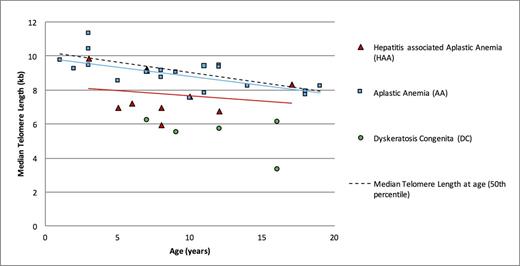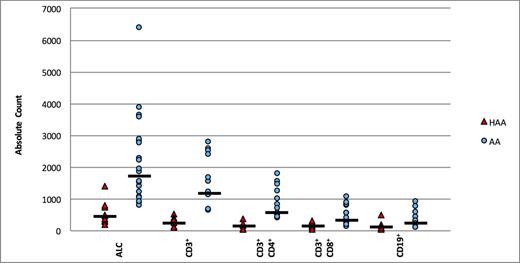Abstract
Acquired aplastic anemia (AA) is a hematologic disorder characterized by low blood counts and a hypocellular bone marrow, caused by autoimmune destruction of early hematopoietic cells. The diagnosis of AA is made by excluding other disorders that can present with bone marrow failure (BMF). Such disorders include dyskeratosis congenita (DC), a multisystem BMF syndrome, caused by an inherited defect in telomere maintenance. Although classical DC presents in childhood with stereotypical mucocutaneous changes, milder forms of telomere dysfunction associated with mutations in TERT and TERC genes can present with non-syndromic bone marrow failure clinically indistinguishable from AA. In clinical practice, lymphocyte telomere length measurements are used as a first-line screen for inherited telomeropathies before initiating treatment for AA.
In our BMF center, we have observed that several patients with features of hepatitis-associated AA (HAA) had lymphocyte telomere lengths at diagnosis at or below the first percentile of age-matched controls, in the range similar to inherited telomere disorders. To confirm our initial observation, we performed a retrospective analysis of telomere lengths of consecutively enrolled HAA patients with non-hepatitis associated AA patients in our institution.
A total of 30 patients with AA were included in this study: 10 had HAA and 20 had other AA (Table 1). The median age at telomere testing was 8.0 years (range 1-19 years). There was no significant difference in age or disease severity between the two groups (p=0.827). The patients' median lymphocyte telomere length (TL) was significantly lower in the HAA patients compared to AA (7.4kb versus 9.1kb, P= 0.021); the difference remained significant after adjusting for patient age (p<0.001). Strikingly, 5 of 10 HAA patients had telomeres at or below the 1st percentile of age-matched normal controls, within the diagnostic range for telomeropathies (Figure 1A). None of these 5 patients had clinical features of DC. As a comparison, TL measurements of genetically-confirmed DC patients (Figure 1) demonstrated TL below the 1st percentile for age-matched controls, and within a similar range to that seen in the HAA patients. To ensure that the significantly lower telomere lengths in the HAA patients were not caused by an occult TERT or TERC gene mutation, the five HAA patients with TL below the 1st percentile were screened for germline mutations in TERT and TERC. A known heterozygous polymorphism, Ala1062Thr was found in one patient, a known variant with no known telomere defect and no effect on telomere length.
Because differences in lymphocyte activation and subset composition are known to impact telomerase activity, we hypothesized that alterations in lymphocyte populations caused by the unique inflammatory state of HAA could partly account for significantly shorter TL in this population. HAA patients exhibited significantly lower absolute lymphocyte counts and lower lymphocyte subsets across the board, as well as the decreased CD4/CD8 ratio compared to non-hepatitis AA patients (Figure 2). The median telomere length in the two groups was significantly correlated with lymphocyte counts (Pearson correlation coefficient 0.52, p=0.003).
An altered lymphocyte homeostasis such as the one characteristic for HAA limits the specificity of telomere measurements as a screening method to identify patients with AA due to a genetic defect in telomere maintaining genes. As such, short telomeres in HAA in the absence of other features suggestive for DC does not necessarily warrant genetic testing for telomere length. Longitudinal studies of telomeres and study of clonal hematopoiesis in this population is ongoing.
| . | Overall (n = 30) . | AA (n=20) . | HAA (n=10) . | P value* . | |
|---|---|---|---|---|---|
| Patient Characteristic | |||||
| Gender, female n (%) | 12 (40) | 9 (45) | 3 (30) | 0.694 | |
| Gender, male n (%) | 18 (60) | 11 (55) | 7 (70) | ||
| Age at diagnosis, y, median (range) | 8.0 (1-19) | 8.3 (1-19) | 7.5 (3-17) | 0.827 | |
| Disease Severity, n (%) | 0.999 | ||||
| Moderate | 6 (20) | 4 (20) | 2 (20) | ||
| Severe | 22 (73) | 15 (75) | 7 (70) | ||
| Very Severe | 2 (7) | 1 (5) | 1 (10) | ||
| Median Lymphocyte Telomere Length, kb (range) | 8.9 (5.9-11.3) | 9.1 (7.5-11.3) | 7.4 (5.9-9.8) | 0.021 | |
| ≤ 1st percentile of age-matched controls | 5 | 0 | 5 | ||
| 1-10th percentile of age-matched controls | 5 | 5 | 0 | ||
| > 10th percentile of age-matched controls | 20 | 15 | 5 | ||
| . | Overall (n = 30) . | AA (n=20) . | HAA (n=10) . | P value* . | |
|---|---|---|---|---|---|
| Patient Characteristic | |||||
| Gender, female n (%) | 12 (40) | 9 (45) | 3 (30) | 0.694 | |
| Gender, male n (%) | 18 (60) | 11 (55) | 7 (70) | ||
| Age at diagnosis, y, median (range) | 8.0 (1-19) | 8.3 (1-19) | 7.5 (3-17) | 0.827 | |
| Disease Severity, n (%) | 0.999 | ||||
| Moderate | 6 (20) | 4 (20) | 2 (20) | ||
| Severe | 22 (73) | 15 (75) | 7 (70) | ||
| Very Severe | 2 (7) | 1 (5) | 1 (10) | ||
| Median Lymphocyte Telomere Length, kb (range) | 8.9 (5.9-11.3) | 9.1 (7.5-11.3) | 7.4 (5.9-9.8) | 0.021 | |
| ≤ 1st percentile of age-matched controls | 5 | 0 | 5 | ||
| 1-10th percentile of age-matched controls | 5 | 5 | 0 | ||
| > 10th percentile of age-matched controls | 20 | 15 | 5 | ||
*P-values are obtained by Fisher's exact test for gender and disease severity and by Wilcoxon test for age and telomere length.
No relevant conflicts of interest to declare.
Author notes
Asterisk with author names denotes non-ASH members.



This feature is available to Subscribers Only
Sign In or Create an Account Close Modal